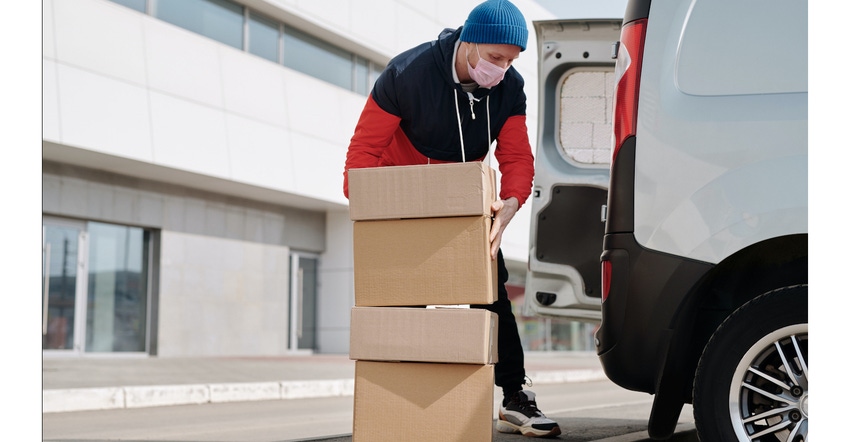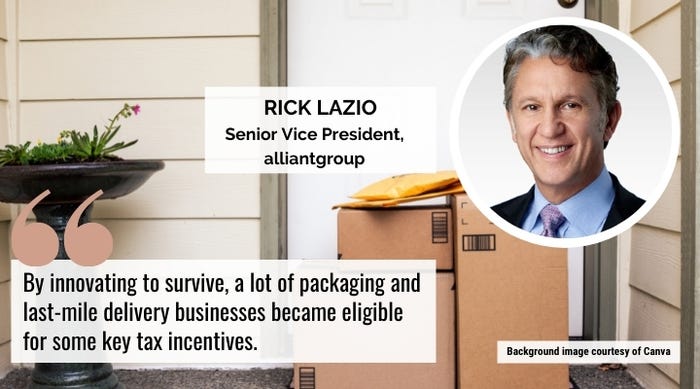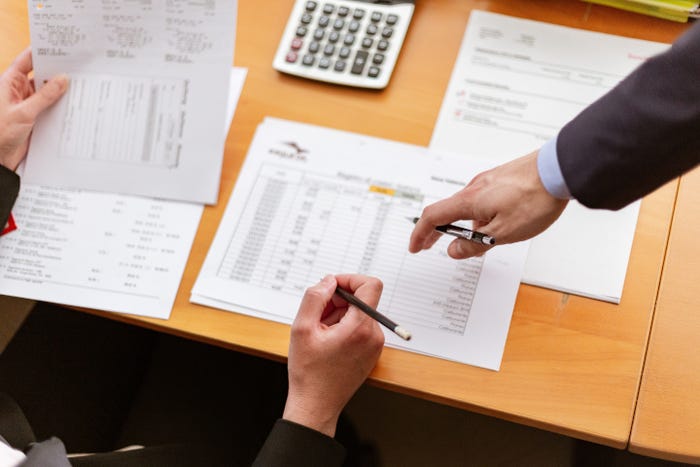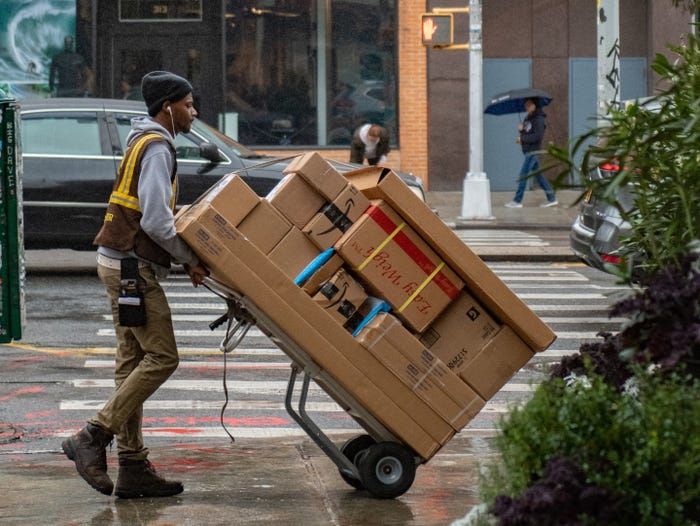Is Your Ecommerce Packaging Eligible for Tax Rewards?
Packaging departments and last-mile delivery companies should leverage these two tax credits to help them recover from COVID-19 economic hits.

The pandemic shook the last-mile delivery ecosystem to its core, causing businesses to scramble to satisfy social-distancing protocols and reach customers stranded indoors due to lockdowns.
Stores became mini-warehouses, parcel-drop numbers skyrocketed, and store shipping and curbside pickups became the norm — all to adapt to shifting customer behaviors. Consumers ordered more, waited less, and expected delivery in tamper-free, COVID-19-safe packaging. And yet, they remained resistant to paying extra to help share merchants’ burden of increased costs.
Regardless of whether a business was an established ecommerce brand or a regular brick-and-mortar retailer, it improvised. Or rather, only those that improvised survived. And by innovating to survive, a lot of packaging and last-mile delivery businesses became eligible for some key tax incentives.

These tax incentives can specifically benefit businesses that had to tackle the following COVID-19-related challenges:
• Addressing safety by choosing packaging that not only suited perishable and delicate products but was also COVID-19-safe.
• Supporting high demand for essential items such as food, household necessities, and pharmaceuticals by developing reliable last-mile delivery networks.
• Catering to evolving consumer expectations of quality and safety by providing same-day and contactless delivery.
• Managing increased operational costs in the face of diminishing profit margins.
While businesses in the last-mile ecosystem had an incredible opportunity to grow, they still had to persevere through these challenges and make some extremely tough decisions. In doing so, they held the US economy together by delivering medicines and other essentials while the pandemic raged.
In facing the unique and unforeseen challenges of the pandemic, these businesses had to:
• Improvise by automating inventory management, investing in new packaging solutions, and setting up new delivery processes.
• Make tough decisions like reshuffling the workforce, paying employees not to work, or even shutting down temporarily to develop ecommerce infrastructure.
Consequently, the US government wants to reward these businesses for their ingenuity and decisiveness and pay back in kind to all businesses that have helped keep citizens fed and safe through the following tax incentives:

1. Section 41 R&D Tax Credit
The R&D tax credit has been rewarding innovation since 1981. Initially introduced to keep technical talent within the country and drive innovation, this credit has evolved and can now be claimed by all businesses that develop custom and unique solutions to optimize operations. Activities that qualify for this credit include but are not limited to improving manufacturing techniques, increasing the shelf life of food, and building efficient containers.
This credit saves businesses $10 billion every year. And yet, only 25% of eligible companies claim it. Why? The reason is a lack of awareness. Since the requirements for claiming this credit have changed drastically within the past year, it’s crucial for brand owners and last-mile delivery business owners to understand and take advantage of everything they’re entitled to this year.
Businesses involved with the last-mile ecosystem have clearly pioneered innovation during the pandemic and the following examples are only a handful of activities packaging departments engage in every day that qualify them for the R&D tax credit:
• Investing in packaging solutions that are durable, return-ready, and easy to open for ecommerce deliveries.
• Digitizing most aspects of operations, including automated warehouses and contactless delivery methods.
• Embracing emerging technologies for last-mile delivery like drones and autonomous mobile robots.
For an example of the R&D credit in action, a packaging company qualified for the R&D credit by creating new packaging and display solutions used for storage, protection of materials, and retail displays. With an annual revenue of $172 million, this business received $876,000 in federal credits for its innovation efforts.
2. Employee Retention Credit (ERC)
Initially introduced as a coronavirus-relief provision to reward businesses that retained employees during the pandemic, this credit has expanded in scope and can now be claimed for:
• Partial or full shutdowns.
• 20% decline in revenue from 2019.
• Interrupted operations.
• Supply chain interruptions.
• Inability to access equipment.
• Limited capacity to operate.
• Inability to work with vendors.
• Reduction in services or goods offered to customers.
• Reduced operating hours.
• Modified hours due to increased sanitation of the facility.
This credit has the potential to eliminate payroll tax and generate an instant cash refund for businesses that were impacted due to disruptions, or a lack of ecommerce infrastructure.
For example, a company in New York that experienced a partial shutdown due to executive orders had to limit its occupancy to 50%. This prevented employees from performing routine activities and reduced their productivity by 11%. After claiming the Employee Retention Credit, they received more than $2 million in credits to recover.
There are common misconceptions surrounding the Employee Retention Credit that have kept eligible businesses from even attempting to claim it. The first is that businesses can only claim this credit if they experienced massive revenue losses — but this couldn’t be further from the truth.
Congress revised and vastly expanded eligibility for the credit by creating opportunities for companies that may have only experienced a modest revenue change, or those that would have seen more growth if they hadn’t faced government-ordered COVID-19 restrictions. Even if your workforce adapted and worked from home, you may well be eligible.

The second area of confusion surrounding the Employee Retention Credit is that companies who were “essential” can’t take the credit. Again, the requirements for the incentive do in fact extend to those businesses.
In the end, Congress and President Biden want small and midsized companies to take the credit, not only because they may have faced COVID-19 headwinds, but because millions of workers who were in the workforce pre-COVID-19 are now on the sidelines. By taking the Employee Retention Credit and reinvesting in their workforce, these companies can create more jobs and help bring these folks back.
For any packaging department and last-mile delivery businesses that survived the pandemic, chances are they are eligible for both these credits, which can be claimed retroactively for prior years. It’s important to note that the value of the benefits received can be influenced by factors like the size of business and other incentives claimed. Therefore, it’s best for businesses to have expert help when claiming multiple incentives together. This will not only maximize the value they can receive, but also ensure they are in the IRS’s good graces, helping them continue to innovate for years to come.
Rick Lazio is currently a Senior Vice President at alliantgroup and a former US Representative from New York. Lazio served in Congress from 1993-2001. After Congress, Lazio moved to the private sector working for JP Morgan Chase as a Managing Director and then Executive Vice President.
About the Author(s)
You May Also Like




